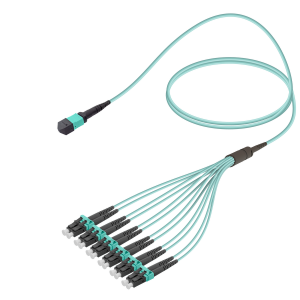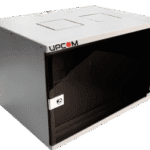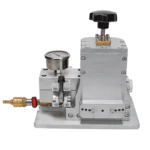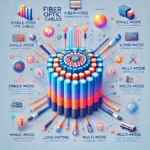13 Dec What is MPO Cable
What is MPO Cable?

MPO Cable
Executive summary Push On (MPO) Multi-fiber Connectors – Fiber connectors consisting of several optical fibers are multi-fiber push on connectors, or MPOs for short. While described as something of an array connector with some more than 2 fibers, MPO Connectors are generally available for typical datacenter and LAN apps with 8, 12 or 24 fibers. Many fiber numbers are usable, like 32, 48, 60 or even 72 fibers, but most are usually seen in large scale switching devices for specialized ultra-high-density multi-fiber arrays.
The word MTP Connector, used interchangeably with MPO Connector, can also be used. The word MTP is a licensed MPO connector patent offered by US Conec. The MTP connector is fully compliant with MPO specifications but are defined by US Conec as an MPO that has now been developed for improved features with quite specified limits. For the purposes of this discussion, because MTPs are deemed to be MPO connectors, we will refer to only MPO connectors.
MPO Cable Background


MPO cable stands for multi-fiber, push-on connector and was originally created by NTT in an effort to minimize the amount of time needed for individual connectors to be spliced by fusion. Originally, ribbon-based MPO connectors were produced as 12, 24, 48 and 72 fiber versions. MPO connectors have been used for FTTH (mass splicing of the ribbon) and Data Centers. MPO is the ‘connector type’ (such as LC, SC, etc.), but there are other variants like USCONEC’s MTP. MTP implies Push-Pull of Mechanical Switch. Basically, variants aim to enhance the basic version of the MPO so that performance is enhanced.
Why is MPO Cable liked by clients?
The MPO has several fibers in one plug, which reduces the time taken to connect fibres. Instead of 12 ceramic ferrula connectors, you have only one MPO connector. This saved plenty of space… by 12/24/48 or 72 in fact!! The other significant benefit of the MPO connector is that the connector has a boundary point/flexibility to add such connectors to other products. You effectively have no flexibility if you splice a cable at both ends. If you want to modify the end connector, you have to cut the fibers. MPO offers you the opportunity to disconnect and adjust the end connections when necessary……customers love this. In turn, this flexibility offers you a backbone cable structure that can be tailored to any mechanical transition or connector change in the future. It’s almost like having an MPO connector electric plug.
For various purposes, you can connect several different kinds of cables into it.
Why the 12th MPO Cable?

12 – 24 Fiber MPO Connector
The first MPO connector to be approved in data centers was the 24, 48 and 72 MPO fiber for FTTX, but they were not sufficient enough for the high data sensitive applications. So we began to see a true trend towards Data Center Backbone cabling with the MPO 12 that could be changed over time. This is referred to as ‘future-proofing’ or ‘migrating. Basically, if you create a backbone with a 12 fiber MPO connector, you can position the end of every connection to be future confirmed (LC, MTRJ, SC etc). In the early days of data centers, this was really useful because nobody really knew what kind of connector configuration they wanted on the switch/server. The MPO 12 has essentially been the connector of choice for most backbone cable infrastructures. The majority of today’s data centers are equipped with backbone MPO 12 fiber and MPO-LC harnesses that attach to equipment such as switches and servers.
The harness is needed to convert from MPO in the backbone to LC at the terminal. Most of the equipment still has an LC transceiver interface today.
Essentially, the 12 fiber MPO connector gives you 6 x serial LC duplex ports per connector. . LC port has a data rate capacity of 1G or 10G (Ethernet).
It was later discovered that you might actually have parallel optics instead of just providing serial transmission. It was possible to transmit 10G of data over a single fiber and over several lanes. A 12 fiber MPO connector could have 6 x 10G fibers for transmission and 6 x 10G fibers for receipt. TO STOP!!!!!!! The transceivers and the computers were only able to handle 40G data rates, so we have a problem here. We have a 12 fiber MPO connector that can supply 60G, but only 40G is actually shipped. This suggests that 33% of the fibers for the connectors were not used. The transceiver used 8 fibers and 4 were only spares.
In the long run nobody really could predict how the market might change, therefore, MPO 12 fiber connector was not the best backbone solution for the people.”
Making work of the 12-fiber connector
Suddenly, all the businesses that marketed the 12 fiber MPO connector did not meet the Data Center specifications anymore. Each piece of machinery that entered the data center was either 40 G (8 fibers) or 100 G (24 fibers). So, what followed was a time of talking about organized cabling suppliers. “If last year you have bought our MPO 12 fiber machine, you now would need to purchase our upgrade products to make it work today…”
12 is not divisible by eight, but it is 24. Vendors of Organized Cabling told their customers…… In the backbone, you combine 2 x 12 fiber MPO connectors…. you can attach 3 x 8 fiber MPO connectors at the switch with zero fiber. This took a while, when everybody had a 12-fiber backbone, which they had to link via an 8-fiber transfer. So here we began to see the introduction of “conversion modules” and “conversion harnesses” that would make the 12 fiber MPO backbone an 8-fiber switch.
However, why do we now have 24 MPO cable?
We have a 24 fiber MPO connector for three significant reasons. This is all around 100 G growth and the 12-fiber MPO’s continuous advancement.
Manufacturers have also built ferrula precision on MPO connectors for some time now. Certainly the 12-fiber MPO connector was the best, but the 24-fiber connector is now much more powerful than the 12. The trouble with MPO connectors is that both of the fibers need a heavy force in the connector. There are two rows of 12 fibers in the 24-fiber connector and this extra row of fibers needs an improvement in the spring force to bring all those fibers together……Double what you really need for 12 fiber MPO Cable.
So, some manufacturers, who claim that this connector must be twice as effective as a 12, began marketing the 24 fiber connector. This is right in so many respects because it is of the same size and has twice as many fiber as 12 MPO fibers. As a 24-fiber optic cable is only slightly larger than a 12-fiber optic cable, it also reduce the quantity of cable needed at the back end.
In addition, why combine 2 x 12 fiber MPO connectors to build 3 x 8 when you can transform only 1 x 24 fiber connector to 3 x 8?
The requirement for 100G channel capacity over a single connector was also fulfilled by the MPO 24 fiber connector. For 100G (10 x transmit and 10 x receive 20 fibers are needed, however some systems using this maximum 120G capacity.
What is now happening?
Well, everybody agrees that 12 backbones of MPO fiber really aren’t perfect. They could be converted to 8 fiber connections and 24 fiber connections, but that’s not productive. You effectively add component cost and optical loss into the connection every time you convert a backbone link. Building a backbone system that has the correct number of fibers for the equipment it links to is much easier. Currently, all transceiver inventions are based on 8 fibers, 16 fibers and 32 fibers. None of these innovations correspond to 12 backbones of fiber, but they certainly correspond with 8.
“For all those who wish to later build a modern worldwide infrastructure with low maintenance cost 8 fiber MPO would be the favorite MPO backbone alternative.”
For the MPO Cable manufactured in Turkey, you can visit us at MPO Cable
Security in Server Cabinet Racks: Protecting Your Critical Infrastructure
Ensuring the security and operational continuity of network equipment is a fundamental priority for modern IT environments. As organizations grow their digital operations, server cabinets evolve into ...
22 November, 2025 No commentHow to Blow Fiber Optic Cable: A Comprehensive Fiber Jetting Guide
Table of Contents Introduction to fiber optic cable blowing Required Equipment and Tools Understanding Fiber Blowing Machines and Their Components Preparing for the Fiber Blowing Process Safety Precau...
19 February, 2025 No commentCable Spooling Machines: The Ultimate Guide to Efficient Cable Handling
In industries such as telecommunications, energy, manufacturing, and infrastructure, the need for Cable Spooling Machines have never been greater. Traditional manual spooling methods can lead to incon...
08 February, 2025 No commentFiber Optic Network Optimization: How to Improve Performance in High-Density Urban Areas
As urban populations grow and the demand for high-speed internet continues to increase, telecom operators face the challenge of optimizing fiber optic network performance in high-density urban environ...
07 February, 2025 No commentEmerging Trends in Fiber Optic Technology: A Comprehensive Guide for European Telecom Operators
Emerging Trends in Fiber Optic Technology; In an era where data transmission speed, reliability, and efficiency are more critical than ever, fiber optic technology continues to be the backbone of tele...
07 February, 2025 No commentFiber Optic Cable Installation: Why Blowing Machines Outperform Traditional Methods
In the world of telecommunications infrastructure, efficiency, cost reduction, and long-term sustainability are key factors that drive innovation. The process of fiber optic cable installation has evo...
06 February, 2025 No commentAdvancements in Fiber Optic Technology: Improving Bandwidth and Transmission Rates
Fiber optic technology has revolutionized the way we communicate, providing faster and more reliable data transmission over long distances. The use of fiber optic cables has become increasingly popula...
03 March, 2024 No commentFiber Optic Cable Installation: The Future of High-Speed Data Transmission
In today’s digital-first world, the demand for high-speed, secure, and reliable data transmission is growing exponentially. Whether it’s for telecommunications, data centers, military applicatio...
03 March, 2024 No comment









